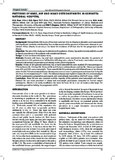| dc.contributor.author | Nour, HA | |
| dc.contributor.author | Oyoo, GO | |
| dc.contributor.author | Joshi, MD | |
| dc.contributor.author | Otsyeno, FMT | |
| dc.date.accessioned | 2015-02-24T08:18:19Z | |
| dc.date.available | 2015-02-24T08:18:19Z | |
| dc.date.issued | 2015 | |
| dc.identifier.citation | Nour, H. A., Oyoo, G. O., Joshi, M. D., & Otsyeno, F. M. T. (2014). Patterns of knee, hip and hand osteoarthritis in Kenyatta National Hospital. East African Orthopaedic Journal, 7. | en_US |
| dc.identifier.uri | http://www.ajol.info/index.php/eaoj/article/view/99199 | |
| dc.identifier.uri | http://hdl.handle.net/11295/80755 | |
| dc.description.abstract | Background: Osteoarthritis (OA) is one of the most common chronic rheumatic disorders and is associated
with significant morbidity and disability. Few studies examined the spectrum of rheumatic diseases in subSaharan
Africa. Obesity is not only a risk factor for incidence of OA but also for the progression of the
disease.
Objective: The aim of the study was to determine the patterns of knee, hip and hand osteoarthritis as well
as obesity prevalence in the patients with established disease.
Design: A cross-sectional descriptive study.
Methods: Patients with knee, hip and hand osteoarthritis were examined to describe the patterns of
osteoarthritis in 201 patients who fulfilled the ACR diagnostic criteria. Their body mass indices were also
studied to determine the prevalence of obesity in this cohort of patients.
Results: A total of 201 patients with knee, hip or hand osteoarthritis were studied. Of these participants,
77% had knee OA, 15% hip OA, 3% hand OA and 5% had combined knee and hip OA. Obese participants
were 41% and 32% were overweight. There were 89 (44.3%) participants with bilateral knee or hip disease
while 112(55.7%) had unilateral disease. Obesity was more common in participants with knee than in hip OA
(45.3% vs 10.3% respectively) P < 0.001. The bilateral disease was higher in obese (55.2%) and overweight
(44.6%) participants compared to participants with normal body mass indices (26.5%) P value < 0.007.
Conclusion: Knee OA was very common and the majority of the patients were overweight and obese.
Bilateral OA was more prevalent in obese and overweight participants compared to normal weight
participants. Obesity is an easily modifiable risk factor for knee OA so it can be made a valid target for
preventing as well as halting the progression of OA. | en_US |
| dc.language.iso | en | en_US |
| dc.publisher | University of Nairobi | en_US |
| dc.title | Patterns of knee, hip and hand osteoarthritis in Kenyatta National Hospital | en_US |
| dc.type | Article | en_US |
| dc.type.material | en_US | en_US |

